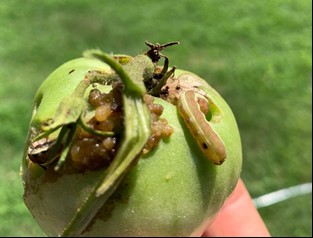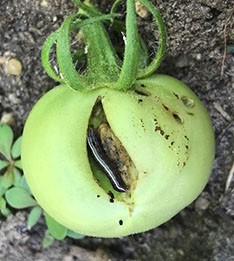Tomato Fruitworm
Searcy, Ark. –
The larvae of several species of moth attack tomato fruit, including the Corn earworm, Helicoverpa zea and the Yellowstriped armyworm, Spodoptera ornithogalli. Tomato Fruitworms, Helicoverpa zea, are destructive pests of tomato, corn, and other crops. The adults are medium-sized moths, pale tan to brown with a dark spot in the center of the fore wing. They lay eggs singly on both surfaces of the leaves. The eggs hatch as creamy white caterpillars with a dark head. They change color as they grow and can be shades of brown, pink, green, or black with alternating light and dark stripes running lengthwise on their bodies. The caterpillars begin feeding on the leaves but move to the fruit as soon as green tomatoes appear.
First noticeable on the fruit is a black hole at the base of the fruit stem. Inside the fruit, tunneling, frass and the worm may be found when the fruit is cut open. When the larvae reach full size, they migrate out of the fruit, fall to the ground, and pupate. Adults emerge from the soil in 10-14 days and begin the cycle again. Caterpillars of the Yellowstriped armyworm are up to 2 inches long and may be green when small to almost black. They have two cream yellow to orangish stripes along the back, and a prominent dark spot on the sides of the fourth body segment behind the head (the first legless abdominal segment). Partially grown larvae appear to have pairs of triangular dark markings along the back of each body segment inside of the light-colored stripes. Adult moths have a wingspan of 1-1/2 to 1-3/4 inches.

Control of both the Tomato Fruitworm and Yellowstriped armyworm consists of scouting for the larvae and handpicking along with chemical controls if necessary. Bacillus thuringiensis (Bt) is a naturally occurring bacterium that is fatal to caterpillars when ingested by them, but harmless to pets, people, and other types of insects. Other insecticides may be used including Baythroid, or Brigade, or Sevin, or Excel, or Coragen, or Voliam Xpress, or Asana, or Belt, or Synapse, or Lannate, or Intrepid, or SpinTor, or Confirm, or Mustang Maxx, or Hero. Homeowners may use Bt, or Ortho Flower, Fruit, & Vegetable Insect Killer, or Ortho Bug-B-Gon Insect Killer for Lawns and Gardens, Sevin, or Spectracide Insect Control for Gardens, or permethrins, or spinosad. Chemical control is ineffective once the fruitworm enters the fruit.
For more information you can contact your local county extension service, you can also follow Sherri Sanders on Facebook @UADA.WhiteCountyAgriculture . The Arkansas Cooperative Extension Service is an equal opportunity institution.
###
By Sherri Sanders
County Extension Agent - Agriculture
The Cooperative Extension Service
U of A System Division of Agriculture
Media Contact: Sherri Sanders
County Extension Agent - Agriculture
U of A Division of Agriculture
Cooperative Extension Service
2400 Old Searcy Landing Road Searcy AR 72143
(501) 268-5394
ssanders@uada.edu
Related Links
The Arkansas Cooperative Extension Service is an equal opportunity institution. If
you require a reasonable accommodation to participate or need materials in another
format, please contact your County Extension office (or other appropriate office)
as soon as possible. Dial 711 for Arkansas Relay.
Pursuant to 7 CFR § 15.3, the University of Arkansas System Division of Agriculture
offers all its Extension and Research programs and services (including employment)
without regard to race, color, sex, national origin, religion, age, disability, marital
or veteran status, genetic information, sexual preference, pregnancy or any other
legally protected status, and is an equal opportunity institution.
